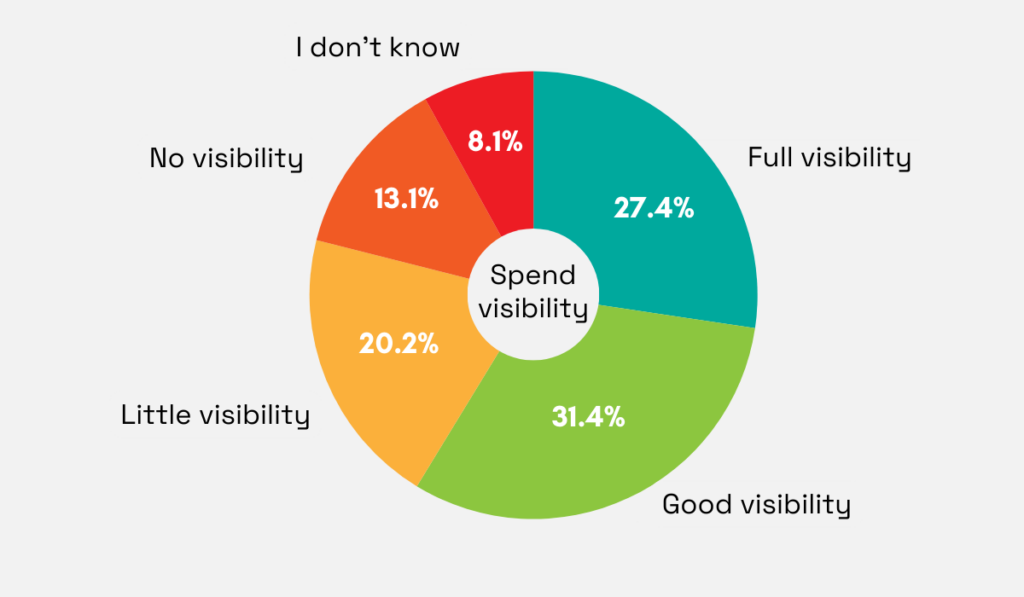How Strategic Spend Management Benefits Procurement


One of procurement’s perennial challenges is to break down silos, regain control over spend and prevent the company from running into trouble.
Strategic spend management benefits procurement in several ways, and today we’re zooming in on five of them.
If you’re a procurement professional looking to elevate your organization’s spend management, this article is for you.
Strategically managing spend is a way to secure complete spend visibility.
Spend visibility means you always know where your spend money is going, giving you clarity and control.
Given its importance, Spendesk’s 2020 findings on spend visibility in Europe may come as a bit of a shocker.
The survey included 600 finance professionals from London, Paris, and Berlin, with over 40% of them reporting that they have little to no insights into where the money is going.

Illustration: Veridion / Data: Spendesk
While it should be taken into account that this is pre-pandemic data on finance teams, the implications for procurement are still huge.
Lack of spend visibility implies a lack of accurate data which is essential for strategic decision-making and overall spend management.
Teams that have full or good visibility into their spend can use data to further improve in any of these areas:
Spend analytics are integral to strategic spend management, but there’s a catch.
Increasing spend visibility can get very difficult if your team is working with poor data or has differing views on spend classification.
Manoj Kumar, Senior Manager at IT services and consulting juggernaut Accenture shared a recent case study detailing these challenges.
Namely, out of 30 experienced sourcing professionals involved in Accenture’s pilot test, only 50% reached 75% accuracy in spend data classification.

Illustration: Veridion / Source: LinkedIn
The test revealed that spend classification can vary significantly even among experts and underlined the challenges related to data quality and lack of standardization.
Kumar explains that conducting spend analysis with inconsistent and incomplete data is incredibly time-consuming, but that there are shortcuts you can take to make it usable.

Illustration: Veridion / Quote: LinkedIn
Automation tools enabled swift data cleaning, while also ensuring standardized spend classification.
Collecting data and extracting meaningful insights from it is a crucial part of strategic spend management efforts, and leveraging technology makes it easier and quicker to increase spend visibility and control.
Putting spend under management through more strategic procurement approaches also leads to a significant boost in operational efficiency.
The truth is that some procurement processes take up huge chunks of your team’s time and focus, and yet they still result in errors.
This is why strategic spend management and automation go hand in hand.
And if you’re wondering what could be the impact of automating processes, just look at this estimate of purchase order costs shared by APQC, one of the world’s leading authorities in benchmarking and performance improvement.

Illustration: Veridion / Data: American Productivity & Quality Center (APQC)
Although the estimate includes several activities like requisition, approval, order placement, and invoice matching, the median cost of a single PO lands at $100.
It’s essential to simplify time-consuming procurement processes before employees’ frustrations start to boil over, but even more so to seize cost-saving opportunities.
Automating purchase order creation and processing tends to be the first step of more comprehensive automation and digital transformation efforts, and that was also the case for OptiFuel Systems.
This international energy company paired up with Velocity for business process review and automation services to overhaul several processes, including those related to procurement.

Illustration: Veridion / Source: Velocity Media
By automating purchase order and invoice processing, as well as approvals, OptiFuel was able to minimize delays and errors and improve operational efficiency.
The benefits of automation include more efficient workflows and fewer errors, and the accelerated processes allow the procurement department to focus on value-added tasks, from supplier relationship management and strategic sourcing to introducing innovation.
Of course, the best way for you to reap these benefits is by adopting robust procurement software solutions to manage procurement, or specific spend management tools to stay on top of POs, contracts, and supplier relationships.

Source: Veridion
Regardless of your preferences, procurement software can automate various processes to enable better spend management and thereby operational efficiency.
Strategic spend management opens the door to better suppliers by allowing you to analyze how money is being spent in ongoing supplier relationships.
Detailed insights into your spending add a crucial dimension to supplier evaluation, helping you differentiate high-performing suppliers from those that aren’t meeting the expectations.
Then you can make strategic decisions about the future of those relationships.
But you need accurate spend data first, and Coca-Cola HBC, one of Coca-Cola’s largest strategic bottling partners, is an excellent example of achieving just that.
Despite having a procurement network of around 13,200 parent-level suppliers, Coca-Cola HBC has few issues with spend categorization.
Moreover, they are screening 97.5% of the total procurement spend involving Tier 1 suppliers while conducting extensive performance management.

Source: Coca-Cola HBC
Ensuring adherence to ethical and sustainability standards, human rights practices, and work safety requirements is a part of these efforts.
However, pursuing this continuous improvement wouldn’t be possible without data.
Data allows you to make informed and confident decisions.
Let’s say you’ve been working with a supplier for nearly a decade and they’ve been reliable so far, but you started to notice some slip-ups.
You disregard these warning signs based on positive past experiences, and this leads to major compliance issues down the road.
That’s because you’re not relying on hard data.
In the words of Aylin Basom, CEO of Supplier.io, whether they’re positive or negative, self-assessments can’t be the basis for your supplier management efforts.

Illustration: Veridion / Quote: Supply Chain Brain
Basom spoke in particular about suppliers’ ESG performance and the importance of making data-based decisions.
One challenge here is getting a good handle on often-fragmented spend data and securing credible supplier intelligence.
Luckily, finding suitable suppliers or enriching the information on current ones based on accurate data and complex criteria is Veridion’s specialty.
Thanks to our APIs you can either comb through our global database of nearly 80 million suppliers and find exactly who you’re looking for, or match and enrich your supplier data to our records.

Source: Veridion
And thanks to real-time data and complex analytics, you can continuously monitor supplier performance and mitigate risk.
Any changes in your suppliers’ business operations that correspond with the risk parameters you set up will result in immediate alerts, allowing you to stay ahead of potential risks.

Source: Veridion
With Veridion’s help, you get both the full picture and the heads-up you need to address unsatisfactory performance and mounting risks.
To circle back to the beginning, the only way you’ll work with better suppliers is if you monitor their performance and collect fresh and relevant data, and the foundation for it comes from strategic spend management.
Collecting, categorizing, and analyzing spend data means tracking down unnecessary expenses or unauthorized expenditures.
Identifying wasteful spending and detecting procurement fraud results in significant cost savings, but strategic spend management goes beyond that.
Spend management becomes the basis of strategic decisions about when and where your organization can expand and invest.
This notion also drives innovation at software industry giant SAP.
Ashwani Narang, SAP’s Vice President and Head of Spend Management, explained that the company’s Intelligent Spend and Business Network solutions now encompass all spending, from (in)direct material procurement to employee expenses and contractual labor.

Illustration: Veridion / Quote: Business World
Such a 360-degree view enables companies to address all areas of spending and unlock new cost-saving opportunities that will give your company’s bottom line a boost.
This doesn’t have to be a monumental change like the one proposed by SAP.
Research by EY shows that simply improving category management can lead to 10-15% in cost savings, not to mention improved supplier relationships and decision-making.
Again, this is where spend management software helps a lot.
It gives you opportunities to track and manage your financial pipeline collaboratively and in real-time, and make use of:
In this way, you can identify savings opportunities but also turn them into projects with milestones and performance metrics.
In conclusion, strategic spend management makes it easier to chart the path to improved bottom line and future success.
Avoiding financial risks is easier when you take a strategic approach to spend management.
One of the critical goals of spend management is preparing for the future, which puts organizing spend data and monitoring expenses high up on the list of priorities.
Fresh, quality data means accurate forecasting and better adaptability which enables you to avoid or tackle major procurement risks that can have a disastrous impact on your organization.
Just take a look at the Procurement Magazine’s 2024 list of top 10 procurement risks, which features:
Supplier-related issues were examined in particular detail during the coronavirus pandemic, with Deloitte’s survey showing that 56% of respondents experienced suppliers going bankrupt while 36% reported that the suppliers simply can’t meet their requirements anymore.
Supplier financial risk remains a looming threat today, but are there any viable solutions to counter it?
A 2015 academic study about developing a supply chain risk prediction model underlines one simple truth: early detection is key.

Illustration: Veridion / Quote: Research Gate
Different prediction models aim to uncover potential risks early on, and there are other signs of supplier financial trouble you can pay attention to.
Moreover, the dawn of generative AI promises new, groundbreaking solutions.
Artificial intelligence excels at information synthesis from multiple sources, enabling businesses to bridge silos, use dynamic forecasting, and enhance their risk management capabilities.

Illustration: Veridion / Source: IDC & SAP
Often, a single prompt is enough to produce detailed risk assessments, scenario simulations, and even mitigation strategies.
If you’re having doubts about your key supplier’s financial state, AI can boost your spend management efforts and neutralize the threat.
Here’s how:
| Real-time Data Analysis | Get a comprehensive, real-time look at potential financial risks. AI can handle vast amounts of data from multiple sources, including financial reports, articles, databases, and forums. |
| Pattern Recognition | Notice patterns and anomalies for early detection of potential supplier issues. |
| Predictive Modeling | Use historical data on supplier performance to identify trends and predict future performance and potential risks. AI empowers you to devise mitigation strategies on time. |
| Automated Alerts | Be warned about potential supplier issues based on predefined risk thresholds. AI systems can detect a financial downturn for a critical supplier and notify the relevant personnel right away. |
Continuous awareness of your suppliers’ financial state and performance is an integral part of strategic spend management.
Also, as you bring more spend under management, you prevent risky behaviors such as maverick spending.
The Hackett Group’s 2018 report takes a closer look at maverick or rogue spending, revealing that the most widespread type of maverick spending is purchasing from unapproved suppliers.

Illustration: Veridion / Data: The Hackett Group
As the authors note, this type of non-compliance also carries the most risk because these suppliers haven’t gone through vetting, which increases the chances of vendor fraud or other deceptive practices.
But remember, one reliable way of countering maverick spend and minimizing risk is through strategic spend management powered by software tools.
So, if your goal is to identify and avoid potential financial risks, make spend management your next big investment.
The main takeaway here: agility is the antidote to complexity.
Procurement teams deal with numerous complexities in the present while preparing for the uncertain future, and they don’t have too many allies.
Luckily, you can always count on modern spend management tools to streamline your processes, uncover useful data, and run future scenarios to help you navigate the uncertainties.
All these benefits are within your reach.